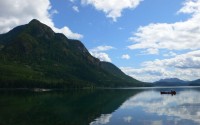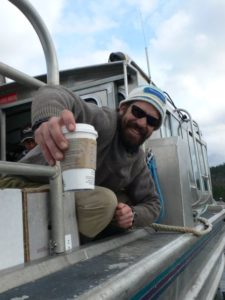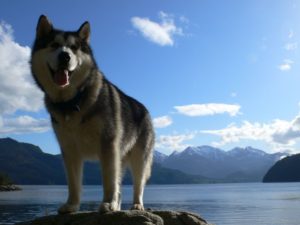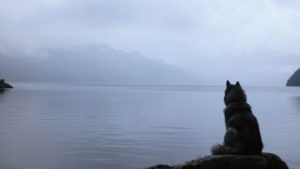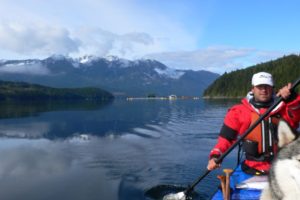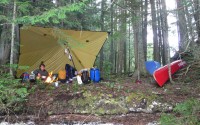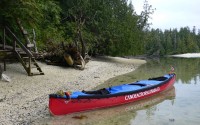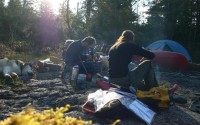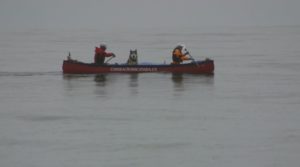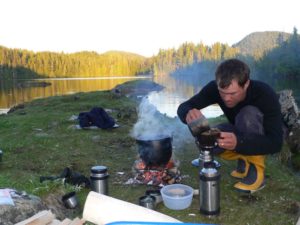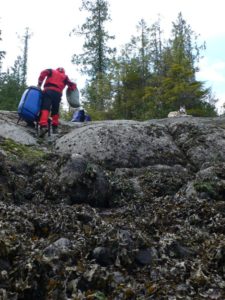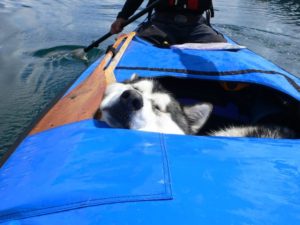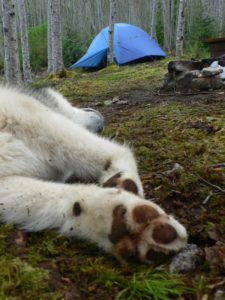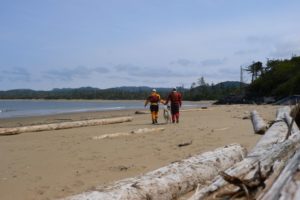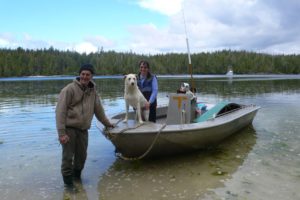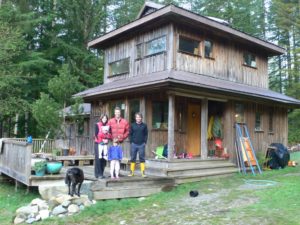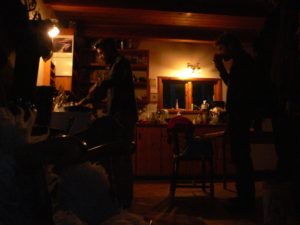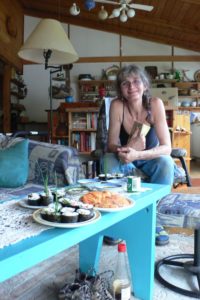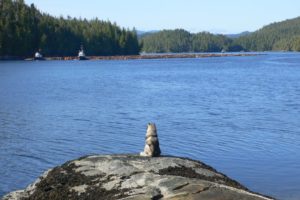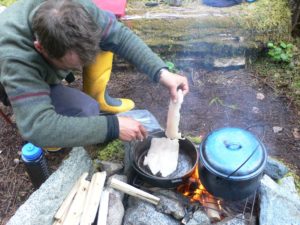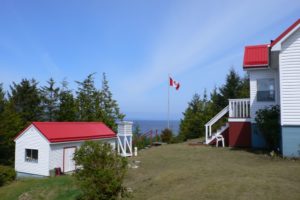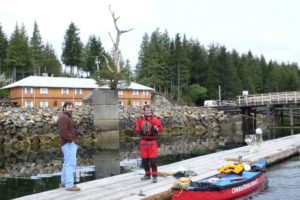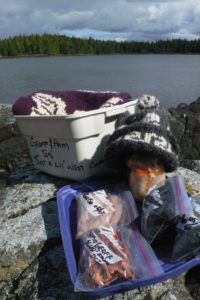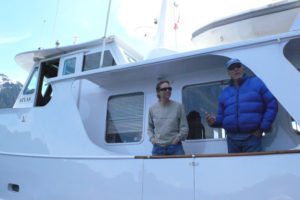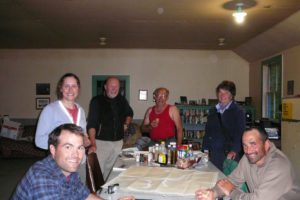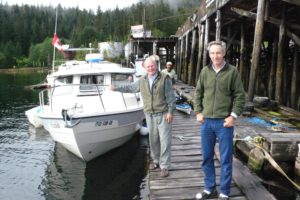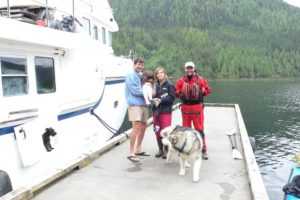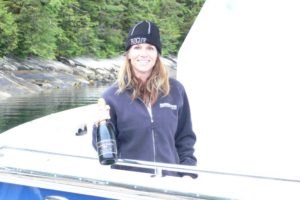Trip Stats:
- Longest Paddling Day = 34.5 nautical miles from Tracey Harbour in Wells Passage to Allison Harbour (next to Schooner Channel)
- Favorite Piece(s) of Gear = Still loving the Spirit Sail (we’ll take all the free miles we can get) and now our Kokatat Expedition Dry Suits (especially the drop seat for ladies 😉
- Average cruising speed without the sail remains at 3.3 knots
- With the sail we have yet to reach the 6 knot mark – but we keep trying!!!
- Most trusted resource(s): Stan Hutchings and Karen Hansen on MV Hawk Bay
- Smelliest thing Taq has rubbed his face in: otter scat
- Number of grizzlies spotted = 0
- Number of black bears spotted = mama and 2 cubs
Hello everyone!
After paddling 100’s of miles of BC’s coast, we have finally arrived in Kitimat, BC. We have met many incredible people and spent a lot of time in breathtaking landscapes. It has taken more time than we thought, but because of our patience, the ocean has been kind to us and allowed us safe passage.
Geoff and I both have a weakness for Starbucks, and Campbell River is the last city that will have one until the BC interior. We stayed with Paul Nimmon & Annik Dumouchel and their two children Amelia and Juliette on Quadra for three days while we resupplied and reworked our gear. Paul was on his way to work in a water taxi and surprised us at Granite Bay with a Starbucks Tazo Chai for me, and a Dark Roast for Geoff. What a treat!
Johnstone Strait taught us a lot about ocean paddling. It is full of wind, waves, rips and current. We spent Geoff’s birthday in Knox Bay waiting for the northwest winds to subside. Taq is pictured above watching the ships pass by.
We took a few detours off Johnstone through the neighbouring channels. One such trip was through Whirlpool Rapids. While we waited for slack tide, Geoff did some fishing and I continued knitting Geoff a wool sweater. This is the first time I’ve ever knit while wearing a dry suit – I’m not sure many people have had the pleasure!
There are a few items that are essential to the enjoyment of an outdoor trip. One of them is toilet paper. In an oversight, we left Quadra with only one roll – it was not going to last 3 weeks. When we realized our dilemma (and with only a few squares left), we stopped at a fish farm to propose buying some. Tyson smiled and handed the two precious rolls to us as a gift. Phew!
So far we’ve camped in a variety of places: driftwood beaches, rock ledges, next to rock walls, sand beaches, clam beaches, on the forest edge, and on narrow islands. They all have their advantages and challenges. Lots of wood for the titanium stove on driftwood beaches (we mailed our beloved stove home in an effort to reduce the number of trips when packing the canoe), but not a lot of space to put a tent. Rock ledges are dry and hard. Rock walls are beautiful, but every sound echoes. Sand gets into everything and everyone, but is great for bare feet and Taq loves to dig dens. Clam Beaches are great, the white shells brighten up the beach at night. Camping above the tide line in the forest is soft, but can be damp. The narrow island had beautiful views all the way around.
The crux of our trip was paddling around Cape Caution, Neck Ness and Kelp Head. In his book, the Wild Coast 2, John Kimantas calls it “one of the toughest stretches of open water along the B.C. coast…The problem is the convergence of water from Queen Charlotte Strait, Queen Charlotte Sound and Smith Sound. The shallow water around the cape exaggerates swell, while the steep granite shoreline leads to strong rebound waves.” We waited 2 full days for the right conditions: low swell and light winds. Linda Lewis in the M/V Royal Sounder, took a group photo of us just north of Cape Caution. Depending on conditions, Geoff and I use a combination of canoe paddles and 245 cm kayak paddles.
Cooking over fire is very cozy, however, we sometimes found it challenging to find dry wood.
Approximately every 3 days, Geoff bakes bannock in our anodized aluminum dutch oven. He makes a variety of flavours: basic, 9 grain, corn, walnut & cranberry etc. Geoff cuts a couple of pieces of bannock and tops it with peanut butter, nutella or honey. We call it “elevensies.” We look forward to it, as it is part of our daily paddling routine.
We have mailed home boxes of gear: titanium wood stove, clothes, books, unnecessary kitchen items etc. We thought we would appreciate these luxury items, however, we appreciate less trips back and forth on treacherous seaweed and barnacles more.
Warning: this paragraph is not for the weak of stomach.
Taq has been excellent in the canoe. He sits relatively still (random ballast) and watches the world go by in a Zen sort of fashion. What he really lives for is when we camp. He runs around making his mark, searching for creatures and their scat.
You may not know this, but the malamute breed has an instinct that drives them to rub their face in smelly things. This includes (but is not limited to) otter, goose, and human scat. Yep – human. As part of our camp routine, Geoff and I must not only bury our waste, but pile rocks on top and around it to prevent him from digging it up. Many times he has returned to camp stinking to high heaven and proudly displaying it on his white head. Isn’t he cute!
We spend 2 hours each morning breaking camp and packing the canoe. Weather permitting, we paddle until 4 pm. The rest of the evening is spent setting up camp, making dinner and breakfast (we make thermos’ of tea, coffee, and red river for the morning), journaling and drying out gear. Once and a while we take time to hang out together and relax. For example, this is a picture of a “romantic” walk on Burnett Bay Beach. If you could ignore the brightly coloured dry suits (aka greenhouses, biospheres etc), freezing cold water, and smelly malamute…we could be in the Caribbean!
This lovely family pictured here is responsible for saving us days of battling a tangled portage. Geoff and I had decided to stop at the beach in Open Bight to stretch our legs and let Taq run around. Stan was doing some PSP testing and had brought his dog, Jesse, along. Taq and Jesse ran and played while we chatted. Stan has worked in the area for over 30 years. When we described our portage route into the Coast Mountains, he raised concerns that the logging road was decommissioned. We had spoken to a couple of people in the area who had assured us it was open. Stan was too polite to push the issue – the conversation moved to other topics and we went our separate ways.
We had been paddling across Rivers Inlet for about a half hour when his boat came up beside us. He was positive it was closed and couldn’t let us paddle away without first confirming it with a couple of knowledgeable sources. The next morning we spoke with him and he confirmed that the logging road had been decommissioned in 2000. This meant the culverts were removed and alders had been growing in for about 7 years. He offered to lend us the charts for an alternate route.
To make an already long story short, Stan and Karen moved their boat, the Hawk Bay, to Fury Island where we were camped and we spent the next couple of days working out an alternate plan. They had electronic and paper copies of the charts for the area. Throughout the time we were there, Karen baked muffins, made grilled cheese sandwiches, lasagna, brownies, bacon, pancakes, etc. In addition to that, she gave Taq bones to chew on and let him eat Jesse’s food.
We truly can’t thank them enough. They made an incredible difference in our lives.
Media coverage:
- Campbell River Mirror: An 8,000 Mile Journey Across Canada by Canoe
- The Orillia Today
- Discovery Islander.ca
We have met many people who have brightened our trip along the way:
- Thank you very much to Paul Nimmon and Annik Dumouchel for their wonderful hospitality. We really appreciated the ride to town to mail home a couple of big boxes of extraneous gear.
- Greg helped us load all our gear to take down to the water. He also gave us some golden advice: he treats his dry suit as his business suit – he wakes up and puts it on every day he is paddling to be safe. From then on we wore our dry suits every day without fail. They kept us warm and dry along the coast.
- Jenny Cooke at Chatham Channel Lodge put us up in a beautiful cabin and fed us large amounts of excellent food. We got along as though we’d known each other for years.
- Debbie Holt and Chris Schever’s at Sullivan Bay Marina gave us some delicious frozen prawns to eat.
- A big thank you to David M. “Mac” Shelton and Frauke Rynd for making the Allison Harbour Co-op Cabin available to the public. We waited out the wind for two nights in their beautiful cabin.
- We spent a couple of windbound days watching the tugs work the log booms. Ian and Dan came to our camp in their tug and gave us fresh halibut (10 min. old) as well as a big bag of groceries.
- Ken & Dottie Saville invited us to have dinner on their boat the Dreamweaver with Jo & Ade Salzer. It was an unexpected treat of salad, chicken, fish and wine. In addition, they charged our camera batteries and invited us to use their shower.
- The continuous weather reports from Environment Canada on VHF radio run our paddling lives. We wanted to see, firsthand, one of the lighthouses that supply this information. Addenbroke keepers, Roger and Leslie, took time out of their day to give us a tour (and salmon snack!) of one of the lighthouses on our route.
- Carey Rolf of Cimian Digital Works in Shearwater gave us some photography lessons over a delicious pancake breakfast.
- Jack Wilson and Denise Pootlass put together a tote of Heiltsuk gifts for us in addition to an invitation to stay at one of their cabins along the way. It is a beautiful place and the Sluq, salmon, cod and seaweed was wonderful. We wore the wool tuque and vest in the evenings when it was cool. Thank you!
- Geoff and I were paddling along Graham Reach when a motorboat, Atlas, pulled up behind us. Wiley & Linda (spelling?) asked us if we liked brownies. They gave us a ziploc full and four Bud Light. We ate half the brownies as they pulled away – we couldn’t resist.
- We spent a couple of days with Lou Simoneau and Nick Spaeder in Butedale. Lou is the caretaker of Butedale. He made us a much appreciated spaghetti dinner after we arrived late, tired and damp. We had battled the wind and current all day. Nick is a kayaker who arrived shortly after we did. He is paddling from Vancouver, BC to Ketchikan, Alaska. We had a lot of laughs telling stories and eating food.
- The bow thwart broke. It is incredibly important to us because the Spirit Sail is mounted to it. We cherish every free mile of distance it provides us. Ed on the “Rambler” and his friend Frank saw it and immediately pulled countless tools from their boat to fix it. Thank you!
- Thank you to Janice Kyle for holding our supplies in Bella Coola and then sending them to Kitimat after the route change. We were really looking forward to meeting you.
- We stopped at the DeeDee, Larry and Isabella Biggs boat, Nexus, for tea on our way out of the Bishop Bay Hotsprings. We all got chatting, and before we knew it, it was late afternoon! After providing luxurious hot showers, they invited us for a delicious dinner of steak, salad, wine, ice cream and cinnamon rolls. How did they know we’d been talking about steak for days in the canoe? Before leaving the next morning, DeeDee handed us a bottle of champagne as well. Not too many paddlers get to sip champagne in a hot tub on the BC coast. You guys rock!
Where do we go from here?
We will paddle 60 miles from Kitimat to Kemano on the Gardner Canal, stopping to camp at two hot springs along the way. From Kemano we will portage about 50 km over an old logging road over the Coast Mountains into Tahtsa Lake. This is where our freshwater paddling will begin.

